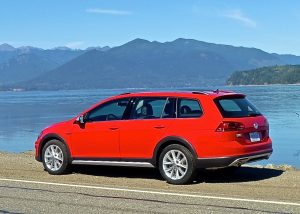2017 Alltrack could renew trust in VW
Filed under: Equinox, Weekly test drives, Autos
By John Gilbert
If it looks like a Sportswagen, has the same utility as a Sportswagen, and goes like a Sportswagen, it must BE a Sportswagen, right?
Not necessarily. It might also be an Alltrack. Volkswagen is expanding the array of solid and substantial vehicles under the Golf brand name by adding a new and much more capable wagon-like vehicle named the Alltrack for 2017.
While it certainly resembles the venerable and popular wagon that used to be a Jetta but recently changed over to Golf livery, the Alltrack comes on the same MQB platform, bolstered with undercarriage armor plating, and with standard 4Motion all-wheel drive, at a bargain price. The price of the basic S model starts at $25,850 for the 6-speed stick shift, rising to $26,950 for the upgraded SE model, and $32,890 for a fully loaded SEL.
All Alltrack models come equipped with VW’s slick, high-tech 1.8-liter direct-injected and turbocharged 4-cylinder gasoline-sipping engine. No mention of the lack of availability of any turobdiesels, which, under the circumstances, is not surprising.
The surprise, to me, is that VW is going to continue offering the Golf Sportwagen, which is exactly the same length and, at a glance, has the same look, but lacks the impressive off-road capabilities. In my naivete, it seemed to make sense to plug in a couple versions of the Sportwagen as the entry-level Alltrack, but that won’t be happening. The Sportwagen comes with either base front-wheel drive or the upgraded 4Motion model, the Sportwagen S Sport.
Five waves of automotive journalists converged on Seattle for the introduction of the Alltrack, with the added lure of VW’s annual all-model presentation for 2017. We spent one day cruising across the harbor from Seattle on the Bainbridge Island Ferry, and drove most of the day around the twisty rural roads of Bainbridge Island as well as negotiating a rugged off-road course. Back to the ferry and Seattle, and the next day we drove up to Snoqualmie, where we found the rest of the VW fleet parked at the Mount Si Golf Club for our use. Read more



 John Gilbert is a lifetime Minnesotan and career journalist, specializing in cars and sports during and since spending 30 years at the Minneapolis Tribune, now the Star Tribune. More recently, he has continued translating the high-tech world of autos and sharing his passionate insights as a freelance writer/photographer/broadcaster. A member of the prestigious North American Car and Truck of the Year jury since 1993. John can be heard Monday-Friday from 9-11am on 610 KDAL(www.kdal610.com) on the "John Gilbert Show," and writes a column in the Duluth Reader.
John Gilbert is a lifetime Minnesotan and career journalist, specializing in cars and sports during and since spending 30 years at the Minneapolis Tribune, now the Star Tribune. More recently, he has continued translating the high-tech world of autos and sharing his passionate insights as a freelance writer/photographer/broadcaster. A member of the prestigious North American Car and Truck of the Year jury since 1993. John can be heard Monday-Friday from 9-11am on 610 KDAL(www.kdal610.com) on the "John Gilbert Show," and writes a column in the Duluth Reader.